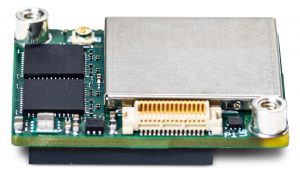BAE Systems, Inc. unveiled its ultra-small MicroGRAM-M GPS receiver compatible with next-generation M-Code military GPS signals that are resistant to jamming and spoofing. About the size of a postage stamp, MicroGRAM-M is the world’s smallest, lightest, and most power-efficient M-Code embedded GPS receiver, according to the company. It provides assured positioning, navigation, and timing (PNT) for size-constrained and other micro-applications.
MicroGRAM-M features rapid secure GPS signal acquisition, enhanced security and resiliency, anti-jamming and anti-spoofing capabilities, and the industry’s lowest power consumption for an M-Code device. The 1.0” x 1.25” x 0.275” MicroGRAM-M has the same physical dimensions as its predecessor, enabling quick upgradability to M-Code and reduced system integration costs. At its core is a proven, tamper-proof M-Code Common GPS Module that encapsulates classified data and signal processing.
[Photo above: U.S. Air Force Explosive Ordnance Disposal specialists with the New Jersey Air National Guard’s 177th Fighter Wing conduct tactical training on Warren Grove Gunnery Range, N.J., June 12, 2020. (U.S. Army National Guard photo by Spc. Michael Schwenk)]
Speaking with Inside GNSS at the Institute of Navigation’s Joint Navigation Conference (ION JNC) in Covington, Kentucky on August 25, Jade Groen, BAE’s Director of Program Management for Ground Products, said “The ultra-small size, weight and power (SWaP) users didn’t have an option prior to this, to move to M-Code. And we all know how important M-Code is to the safety of our warfighters.”
“As the Office of the Secretary of Defense (OSD) continues to ramp up pressure to move to M-Code, ultra-small SWaP users were feeling kind of left out that they didn’t have an option. So we’re very excited to be able to bring this option to those users and ultimately to the warfighters. It brings them pretty extensive anti-jam and anti-spoofing protection, with this application moving to the Increment 1 technology.
BAE Systems has been the only military GPS provider of the MicroGRAM for the last decade. The company started the Microgram-M design process about two years ago, with an understanding of the needs of military ultra-small SWaP users. “We were able to put that knowledge into a size of a package that frankly, many did not think was possible,” added Groen. “Very exciting!”

Richard Fischer, Inside GNSS publisher, asked,”What are the plans in terms of user communities, obviously now with reduced SWaP that can be seen as a game changer?”
Groen replied that the established user base for ultra-small SWAP GPS M-code includes handheld communication radios, ultra-small UAVs and micro UAVs. “We’re already seeing pretty extensive interest [in those communities] and have our first units for this product out now. We’re moving into qualification testing at the end of this month, and we will be in full rate production with this product within the first two quarters of 2022, and customers taking delivery. We are start delivering to customers, right away in 2022.”
When asked about the company’s integration strategy, she said that “The biggest difference between the [earlier] SAASM product and this M-Code product is that the SAASM product was soldered down. The M-Code product is pluggable. We think that that will make integration much easier for our customers, as they move this into their factory. Now, it does mean that they’re going to have a change going into Increment 1. But the beauty is that Increment 2 is already intended to be pluggable, so it should actually allow for better forward-fit in six years when Increment 2 is available.”
“When you’re replacing yourself, you already know how your customers use your product,” she confided.
Groen said that BAE Systems plans for software-only feature upgrades on approximately a yearly basis for the Microgram-M, intended to be field reloadable.
“We’re delivering reliable PNT where our customers need it – from soldiers’ handheld devices to small unmanned aerial vehicles,” added Greg Wild, director of Navigation and Sensor Systems at BAE Systems. “MicroGRAM-M provides our armed forces and allies with a low-SWaP M-Code GPS solution that’s resistant to adversaries’ disruption efforts in highly contested environments.”
“MicroGRAM-M is the latest BAE Systems M-Code military GPS product, joining MPE-M and NavStrike-M, which deliver enhanced awareness in highly contested environments and precision munitions guidance,” said John Watkins, vice president and general manager of Precision Strike & Sensing Solutions at BAE Systems. “Qualification of MicroGRAM-M is underway, with full-rate production expected in 2022.”






